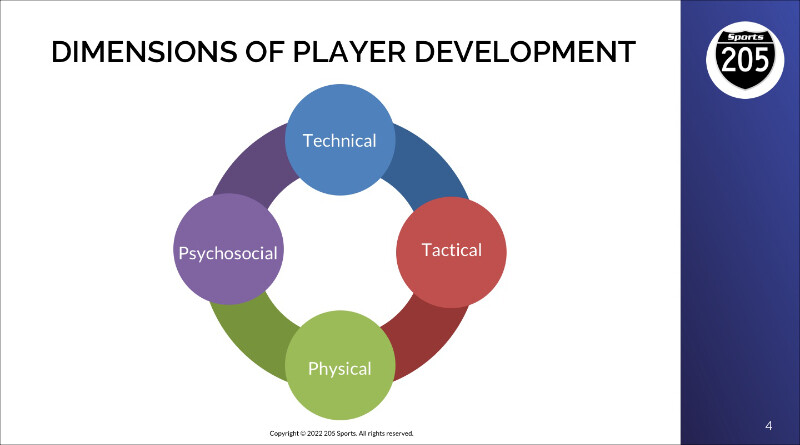

Two key considerations should form the basis of any team session: non-negotiables and periodization.
Underlying an activity should be a set of foundational principles that serve as non-negotiables within a player development context. Once again, we can use the dimensions of player development to outline possible non-negotiables. Each program should have its non-negotiables which should be clearly stated for the players. Non-negotiables can be “scaled” based on age group and maturity and fit within a structure of long-term athletic development.
Here are some possible examples (among many possible examples) of non-negotiables.
- The use of open body positions
- How to play passes to receivers (front foot, back foot)
- The use of specific foot surfaces to carry the ball over short/long distances
- The use of the body to protect the ball when carrying
- The act of scanning to determine the environment (space, positions of teammates and opponents)
- Defensive footwork and body positioning
- The recognition and use of space as a foundation of individual and team actions
- The club/program’s particular style of play in moments of the game and positions on the field
- The level of physical intensity expected from the players
- The mindset and behaviors of individuals and the team – willingness to challenge, response to adversity
When performing session activities with individuals or the team, the coach must consider how to respond when non-negotiables are not met. There are two typical examples – the group collectively is not performing the activity within the required technical abilities (skill level is poor), or individuals or the group is exhibiting undesired psychosocial behaviors.
In the former (skills) case, the coach may adjust the activity to make it simpler (for example, make spaces larger), demonstrate and rehearse correct technique, allow for success, then reinstate the original conditions. Or, the coach may elect to abandon the activity in favor of an exercise to develop the specific skill, then return at a later time or date to the original activity.
In the latter (behaviors) case, the coach will need to decide how to respond based on their assessment of the individuals and group.
Here are some questions the coach might consider:
- Is the issue confined to one player, and is it a one-off or ongoing issue?
- If it is a group issue – is the activity too easy or too hard and do the players understand the activity and its objectives? Does the training need adjustment to engage the players?
- What is the overall morale of the group – how can we create the right environment and messaging to encourage desired behaviors?
As coaches, we must be aware that the psychosocial element drives the actions we see on the field in all other dimensions. It’s crucial that we carefully manage and develop our players’ mental skills, recognizing that both success and adversity are elements of the game and life. A foundational principle at 205 is that football (soccer) is a game of problem-solving. To create problem solvers, we must insert opportunities into training sessions for our players to recognize and solve problems. This approach can be messy at times and requires patience and guidance from the coach. In order for the players to solve problems, we must give them ownership. The desired result is for the players to develop the confidence and character to work through a problem solving process.
As related to non-negotiable tactical behaviors, 205 has adopted the TOVO methodology principles of play, shown below:

The TOVO methodology describes the player’s relationship with their surroundings, the ball, and teammates. While not explicitly prescribing any one style of play, the TOVO principles encourage expansive play with the purposeful movement of the ball within a framework of space.
A second important consideration in team session design is periodization – the breaking up of the training calendar into phases with specific purposes and objectives. Periodization is classically thought of from the physical standpoint – for example, blocks of time devoted to building stamina, strength, explosiveness, or other abilities using specifically designed activities to create load on the players resulting in adaptations. In the context of team session design, we can view periodization across all of the dimensions of development – technical, tactical, psychosocial, and physical. A classic use of “practice themes” such as pressure/cover/balance defensive roles, striker movements, and building out of the back may be combined with physical and technical activities in a warmup phase or within the body of the session plus individual and team-building activities during session breaks.
A summary is that periodization should fit within club/program curriculum objectives taking into account game schedules (ensuring the players are not overstressed) and with ongoing measurables to ensure progress over a long-term plan.